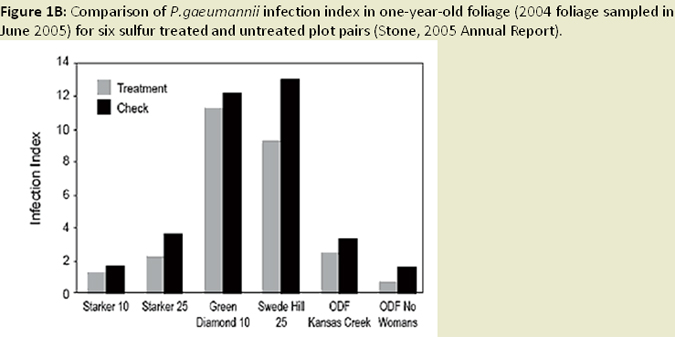Major research findings involving Swiss needle cast and its causal agent:
- Fertilizer influence on SNC disease severity across a gradient of disease: The Beyond N Study
- Effects and Impacts of SNC
- SNC Treatments
- Quantification, Assessment, and Severity Prediction
- Tree Genetics, Resistance, and Improvement
All cited publications are available on our Publications page.
Treatments to mitigate the effects of SNC, particularly fungicide treatments, have been shown to be effective. However, depending on the goals and objectives of the landowner, the application of these treatments may or may not be economically or operationally viable. Many fungicide application treatments have found increased levels of foliar retention (Manter and Kavanagh 2003). Early trials of the aerial fungicide BRAVO, treatment decreased infection rates and increased needle retention and growth rates (Johnson et al. 2003; Figure 1a). Nevertheless, five years of spraying did not achieve complete control of the disease (i.e. Phaeocryptopus gaeumannii fruiting bodies were still present, albeit at lower levels). Two years after fungicide applications ceased, infection levels did not differ between treated and untreated areas. Elemental sulfur has also proved to be effective in reduction of foliage infection, but results may be short-lived (Figure 1b). These results indicate that the benefits of fungicide application are short-lived, as sufficient fungal inoculum remains in the environment to infect needles once fungicide applications are discontinued.
A positive growth response to thinning was observed at all levels of infection, although less so at high infection levels (Mainwaring et al. 2005; Figure 1c). This indicates that growth can be accelerated and maintained through thinning, although responses on the most heavily infected sites may be too low when objectives are oriented strictly for timber production. If objectives range from production to diversifying stand structure, thinning may be a more viable management option in highly infected stands (Figure 1d). Trees in infected stands will respond positively to thinning. Stands should be thinned from below, as the largest trees have demonstrated a greater level of SNC tolerance relative to smaller trees.



